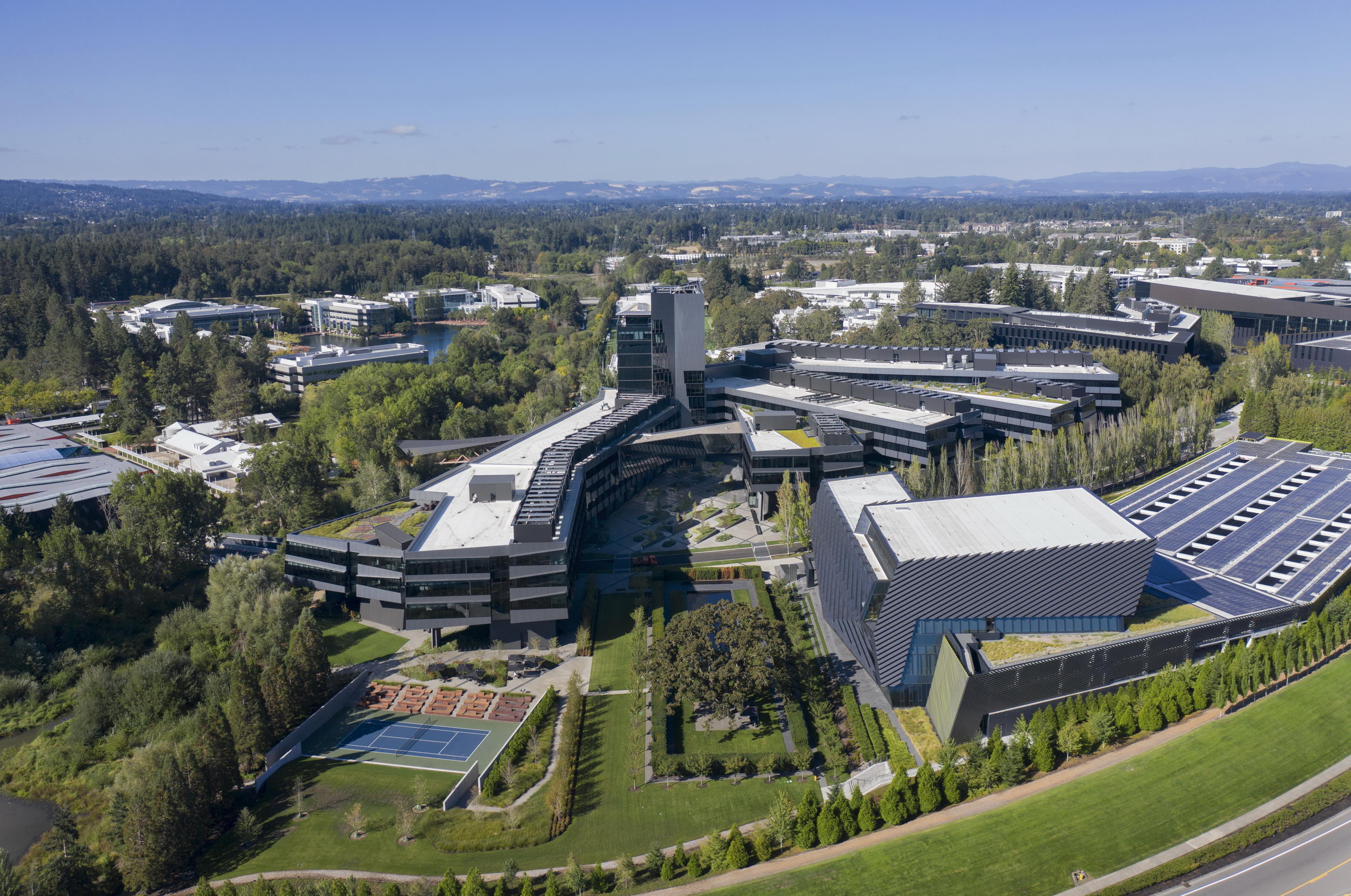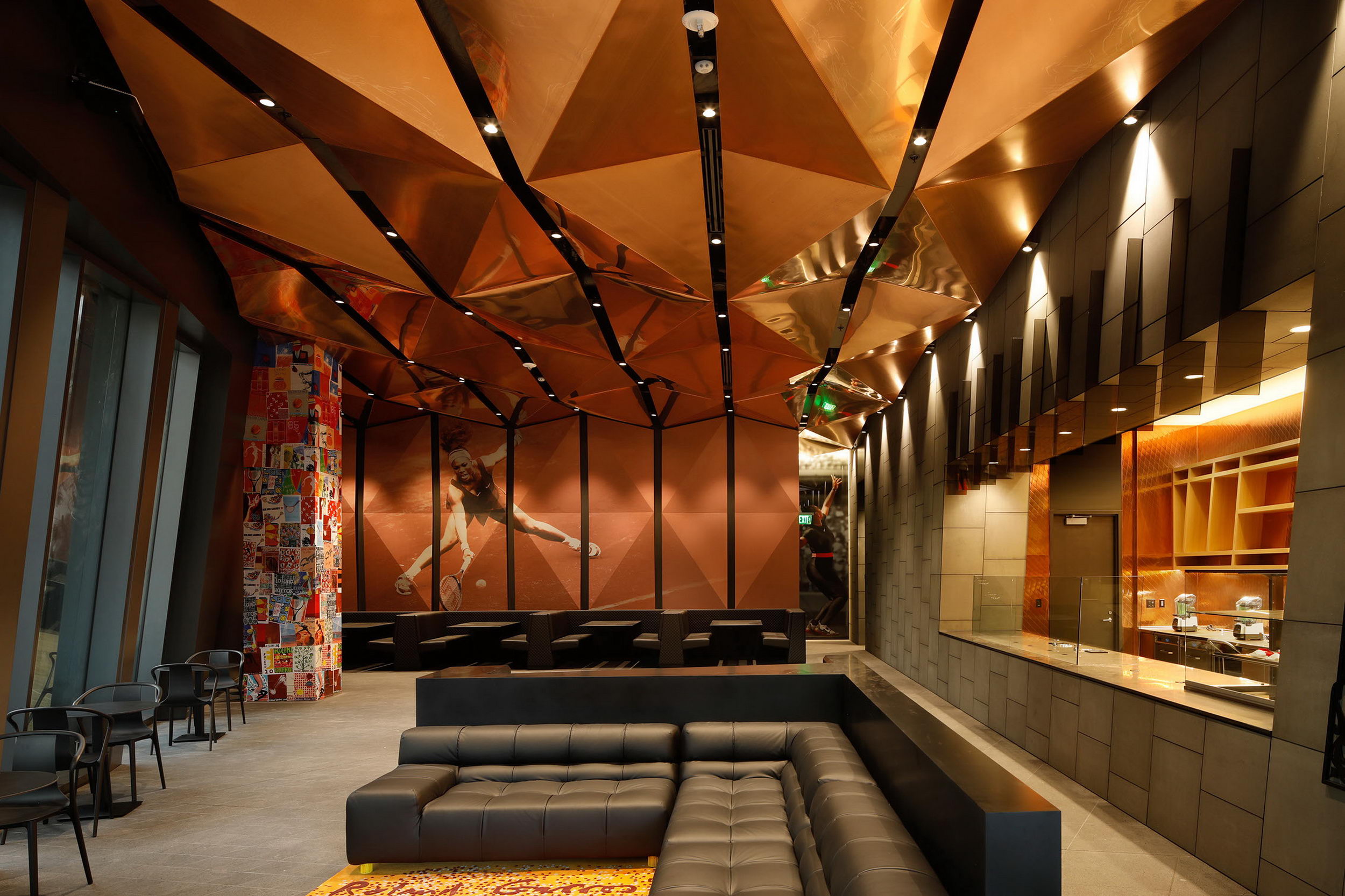
Serena Williams Building是一座可容纳2750名员工的办公大厦,面积超过100万平方英尺,是耐克全球总部规模最大的建筑。Skylab建筑事务所负责这座复杂建筑的各方面的设计,包括其核心和外立面、室内设计和家具选择以及品牌整合。除庞大的规模之外,该项目还面临三个主要挑战:
The Serena Williams Building—aworkplace for 2,750 occupants at more than 1 million square feet—is the largeststructure at Nike World Headquarters. We led the design of all aspects of thiscomplex building and program, including core and shell, interior design andfurniture selection, and branding integration. Beyond its sheer scale, theproject presented three principle challenges:
如何创建一个以设计为中心的工作空间的新原型,以促进大规模的化学和协作。
• How to create a new prototype for design-focused workspace that fosters chemistry and collaboration on an enormous scale.
如何利用再生原则,通过与大自然的合作为场地和建筑居住者进行设计。
• How to leverage regenerative principles to design for both the site and the building occupants through a partnership with nature.
如何展现体育精神、耐克的传统,以及Serena Williams(网球运动员,建筑以她命名)
的精神
• How to capture the ethos of sport, Nike’s heritage, and the spirit of Serena Williams, the ultimate warrior-muse and the building’s namesake.



该建筑由四部分组成:地下停车场和布景装卸处、模型零售空间的销售中心、针对多个产品类别的综合设计工作室,以及一座12层高的塔楼,为整个园区提供公用设施。设计中不可或缺的是流动的概念——一种既高效又开明的流体状态设计策略。流动性促进了设计师之间以及业务不同部分之间意想不到的联系和可能性。设计师创造了各种规模的公用空间,以促进室内和室外的身份和联系。该建筑围绕一个原则进行组织,即企业内每个品牌的所有设计师都占据一个级别,而服务则在级别之间垂直堆叠。对于耐克来说,这是第一次,产品从草图到模型、到最终设计、再到零售固定装置,所有工作都能在同一屋檐下进行。
The building consists of four parts:an underground parking garage and loading dock; a merchandising center forprototype retail spaces; integrated design studios for multiple productcategories; and a 12-story tower with shared amenities for all of campus.Integral to the design is the concept of flow -- a fluid state design strategythat is both efficient and enlightened. Flow facilitates unexpected connectionsand possibilities, both among designers and between disparate parts of thebusiness. We created a variety of scales of gathering spaces to foster identityand connectivity, both indoor and outdoor. The building is organized around aprinciple that all designers for each brand within the business occupy a singlelevel, while the services stack vertically between levels. In a first for Nike,products can move from sketch to prototype to final design to retail fixtureall under one roof.




▽室内办公空间

 |  |


 |  |


在过去,场地包含一个停车场和一条通往相邻建筑物的通道,位于园区已经远离的美丽湿地旁。对于设计师来说,再生设计涉及与大自然的积极合作,通过负责的系统和材料进行尊重的场地设计和智能施工。为了更好地与自然景观相连,设计师将现有的通道和停车场进行遮盖,以尽量减少汽车和卡车出现在场地中。在体量方面,建筑的每个独特的横栏和侧翼都向南倾泻而下,并带有可居住的交错绿色屋顶露台,可俯瞰湿地。260 kW光伏阵列从视野中屏蔽屋顶机械单元。建筑还收集雨水,并循环利用于湿地。
In its former life, the building sitecontained a parking lot and an access road to an adjacent building, all next toa beautiful wetland that the campus had turned away from. For us, regenerativedesign involves working with nature as an active partner towards bothrespectful site design and intelligent construction with responsible systemsand materials. To better connect to the natural landscape, we buried theexisting access road along with all parking and loading to minimize the visualpresence of cars and trucks. In terms of massing, each of the building’s distinct bars, or wings, cascade to the south and featureinhabitable, interlacing green roof terraces that overlook the wetland. A 260kW photovoltaic array screens rooftop mechanical units from view. Stormwater iscollected and returned to the wetland.




由分支横杆产生的负空间的处理方式与内部空间本身的处理方式相同。庭院、花园、广场和下沉式网球场打破了建筑的规模,为工作、娱乐和放松提供了非正式的户外空间。自然光从两侧的玻璃窗和连通楼梯上方的天窗照射到每根横杆围合起来的办公空间。内部裸露的混凝土为设计工作室提供了原始而开放的色调,并彰显了建筑结构。节能机械系统包括排量通风和辐射帆。当建筑设计达到城市设计的规模时,可持续性的重要性毋庸置疑。
The negative spaces created by thebranching bars are treated with the same sensitivity as the interior spacesthemselves. Courtyards, gardens, plazas and a sunken tennis court break downthe scale of the building and provide informal outdoor spaces for work,recreation and relaxation. Natural light floods the workspaces along each barfrom glazing on two sides and skylights above communicating stairs. Exposedconcrete on the interior provides a raw, open palette in the design studios andexpresses the building’s structure in key moments. Energyefficient mechanical systems include displacement ventilation and radiantsails. When building design reaches the scale of urban design, sustainabilityis non-negotiable.





Skylab Architecture team
Jeff Kovel, Design Director
Brent Grubb, Project Manager
Susan Barnes, Project Director
Robin Wilcox, Project Director
Nita Posada, Interior ArchitectureLead
Louise Foster, Project Designer
Project team
Architecture and Interior Design -Skylab Architecture
Building Enclosure - Facade Group
Civil Engineering - WHPacific
Code Consultant - Code Unlimited
Contractor - Hoffman Construction
Kitchen Consultant - HDA
Landscape - Place Landscape
Lighting - Luma
Mechanical/Electrical/Plumbing - PAE
Signage/Wayfinding- Ambrosini Design
Sound - Listen Acoustics
Specifications Consultant -M.Thrailkill
Structural Engineering - ThorntonTomasetti
Sustainability Consultant –Brightworks
Photography
Jeremy Bittermann